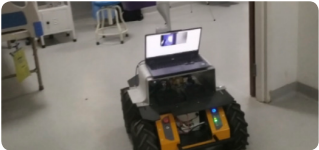Institute:
Institute of Information Technology, Mandi
PI Name:
Prof. Laxmidhar Behera
Technology Readiness Level (TRL)
4

| Weight and Battery life | 30-35 kg, typically 2 hrs |
|---|---|
| Mobility System | Wheels for movement. Camera System: High-definition RGB cameras for visual monitoring and LiDAR for navigation and obstacle detection |
| Manipulation Capabilities | Single robotic arm (7-DoF) with 2-finger gripper |
| Navigation and Mobility | Indoor autonomous navigation, anti-collision technology, and adjustable speed |
| Lift Capability by Robotic Arm | Dry electrode based headset and wireless model |
| Communication and User Interface | Maximum 5K g |
| Communication and User Interface | Touchscreen displays for manual controls, Voice interaction via microphones and speakers |

MZ-122, IIT Delhi, Hauz Khas, New Delhi-110016 India
IHFC, Block – A, Research & Innovation Park, IIT Delhi, Hauz Khas, New Delhi – 110016
07AAFCI6629H1ZE
Designed & Developed by eClerx
© Copyright IHFC 2025 All Rights Reserved.
At Alphoenix Design Pvt. Ltd. We provide custom design and development of high-efficiency BLDC motors for different sectors like EVs, Aviation and Drones, Industrial machinery and Household appliances.
We’ve designed our motors in such a way that its manufacturing process would reduce material waste of motors by 70% and increase efficiency by 5-8%. Our flagship motors provide an efficiency of around 92%-95%. The motor will be manufactured with the capability to utilize CRGO (Cold-Rolled Grain-Oriented) material in its construction.
Our radial flux motors can provide such efficiency with easy manufacturing processes. Utilizing our new motor makes it feasible to achieve an efficiency rating exceeding 95%.
Founded by Marico, Parachute Kalpavriksha Foundation’s objective is to make a difference in the life of Indian farmers. The word “Kalpavriksha” is derived from Devanagari script “Kalpa” (imagination/wish) and “Vriksha” (Tree), meaning the tree that fulfils your wishes. We are a Non-Profit organization working towards the welfare of farmers in India. Currently we have enrolled more than 65,000 farmers covering almost 2.75 Lakh acres of plantation across the states of: Tamil Nadu, Karnataka, Kerala and Andhra Pradesh.
Our team of 100+ Agronomists regularly pay visits to the farmers and educate them on scientific farming practices and help them increase their productivity. Apart from our Productivity improvement program, we provide other services like Agri Expert on phone, Agri Business Centers (ABC), Water conservation activities by construction of farm pond, classroom training to farmers through Kalpavriksha Knowledge Centre etc.